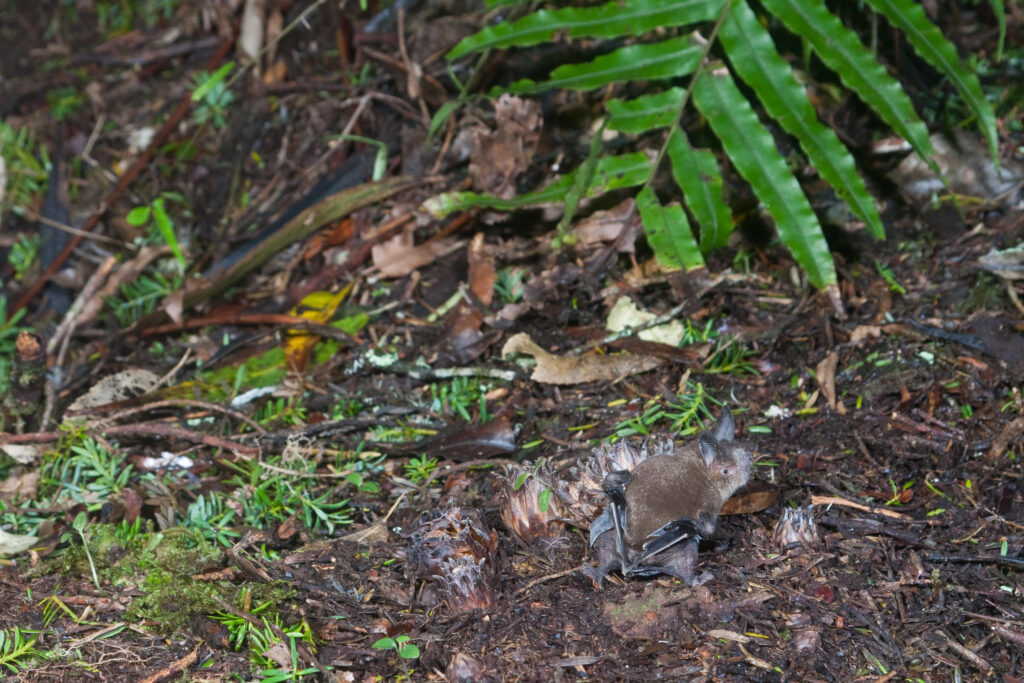
(Photo by David Mudge, Ngā Manu Images)
(Full article from RATS Tales July 2020)
New Zealand’s problems with invasive exotics began hundreds of years ago when Polynesian rats (kiore in Maori) arrived in Maori voyaging canoes. Black and Norway rats came later, with European ships. For a variety of dubious reasons, British colonists and other Europeans intentionally introduced a whole menagerie of creatures from their homelands, from songbirds to red deer. Livestock and domestic pets went feral. A few species, like the brushtail possum, were brought in from Australia.
While many of these exotics have had negative impacts on native flora and fauna, the rats have been the worst, preying on the eggs and young of ground-nesting birds that never evolved defenses against mammalian predators. New Zealand’s government has responded with aggressive rat-control efforts, relying heavily on the first-generation anticoagulant rodenticides (FGARs) diphacinone and pindone. Inevitably, non-target native species have suffered. Some of the collateral damage has involved secondary poisoning of birds, like morepork owls (known as boobok owls in Australia) that ate poisoned rodents, and Stewart Island robins (see “A New Silent Spring” in our May 2020 RATS Tales) that apparently fed on insects that had ingested bait.
Another victim came as more of a surprise: the lesser short-tailed bat (pekapeka-tou-poto in Maori), one of the country’s two remaining native land mammals (the other is the long-tailed bat). The discovery of diphacinone-poisoned short-tailed bats in 2009 presented a paradoxical dilemma: how to eradicate rats that threaten the bats’ survival without harming bats themselves. Gillian Dennis, who documented the poisoning in her PhD dissertation at Massey University, wrestles with that conundrum. She’s currently the project manager of the Bat Recovery Project of the non-profit Forest & Bird (the New Zealand equivalent of National Audubon).
Bats are eccentric creatures, but the lesser short-tailed is anomalous even by bat standards. The species has no close living kin (the greater short-tailed bat hasn’t been seen since the 1960s and is presumed extinct); fossils of related species are known from Australia. The lesser short-tailed can fly perfectly well but often chooses not to, scrabbling around the forest floor or climbing trees with its wings furled against its sides. Its diet includes not just insects like the cricket-like weta and other invertebrates, but pollen and nectar (it pollinates a parasitic plant called the wood rose that produces copious nectar in autumn), fruit, carrion, and the carcasses of sooty shearwaters (“muttonbirds”) harvested for human consumption. When foraging, it appears to rely less on echolocation than on smell; it has been described as snorting and snuffling like a tiny pig as it roots through leaf litter. Like many other bats, it forms communal roosts, but is unique in excavating roosting cavities in dead wood with its teeth. Males engage in competitive “lek” display, gathering in groups and singing to attract females—a behavior widespread among birds, rare in mammals. The long-tailed bat is much more conventional.
Like many of New Zealand’s endemic birds and reptiles, the lesser short-tailed bat has been hard hit by habitat loss and predation, and by competition from invasives including stoats (European weasels), cats, and possums, as well as rats. Although still present on both of the country’s main islands and some smaller offshore islands, it has been reduced to a dozen populations totaling only 50,000 or so; its three subspecies have been classified as either threatened or at risk (the southern subspecies is starting to recover).
While working for the New Zealand Department of Conservation, Dennis studied one such remnant population in the Pikiariki Ecological Area of North Island’s Pureora Forest Park, a 290-square-mile old-growth temperate rain forest preserve. To monitor their numbers and track their movements, she captured the bats in harp nets (a tool developed by bat maven Merlin Tuttle) and equipped them with small lightweight radio transponders.
In January 2009, during the bats’ breeding season, Dennis and her co-workers found dead and dying bats below two roost trees, one a maternity roost used by females. Over the next month, 115 bat deaths were documented, both pups and adults. Necropsies revealed internal bleeding consistent with anticoagulant rodenticide poisoning, and 10 of 12 liver samples tested positive for diphacinone, used to control black rats (also known as roof or ship rats) in the area. Some of the dead pups had ingested diphacinone with their mothers’ milk.
Although perhaps overshadowed by recent attention to brodifacoum and other second-generation anticoagulant rodenticides (SGARs), FGARs like diphacinone cannot be taken lightly. In a recent filing with the US Environmental Protection Agency, RATS opposed re-registration of diphacinone and chlorophacinone based on findings including: direct toxicity to nontarget wildlife, sublethal immune system damage, susceptibility to notoedric mange in bobcats and other pathogens in other species, and reproductive effects. RATS also noted that diphacinone use in California has increased as access to SGARs has been restricted.
Given the short-tailed bat’s eclectic food choices, Dennis thought the victims at Pikiariki could have been exposed to diphacinone by eating a paste bait nailed to trees in biodegradable plastic bags. However, field and laboratory studies convinced her that the bats had eaten contaminated arthropod prey. Free-ranging and captive bats showed no interest in (rodenticide-free) cereal baits, while arthropods readily consumed them. The role of arthropod vectors would be parallel to the case of the Stewart Island robins. “Weta seem a likely candidate based on their size and their tendency to feed on paste baits,” she says. Her tests indicate that a single large-bodied weta could contain a lethal dose of diphacinone.
It’s unlikely that the bats are themselves vectors. Morepork owls (ruru) prey on short-tailed and long-tailed bats, but Dennis says rats and mice are a more likely route of exposure: “There has been no documentation of secondary or tertiary poisoning of ruru via bats.”
Dennis recommended changes in the way rodenticide was deployed to make it less accessible to either arthropods or bats. “Since the mortality event in 2009, the Department of Conservation has prohibited the use of biodegradable bags to deliver anticoagulant rodenticide baits,” she writes. “Furthermore, anticoagulant-based paste baits cannot be used in areas where bats are present.” Instead, hard pellets of pindone are substituted. She says there have been no further reports of bat mortality events on the scale observed in 2009.
However, exposure continues despite those changes. Over two monitoring seasons in 2013 and 2014, five short-tailed bat pups and one juvenile bat were found dead near maternity roosts at the Pikiariki site; diphacinone residues were detected in two of the bats, although it was impossible to confirm the cause of death. Additional deaths occurred there in 2015, with two of the victims testing positive for pindone, and traces of both FGARs found in guano deposits. “As in other years, it is likely that there were further deaths that were undetected,” she adds. “Ongoing exposure to diphacinone (and later pindone) has been confirmed and poses an unknown level of risk.”
